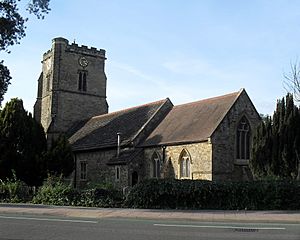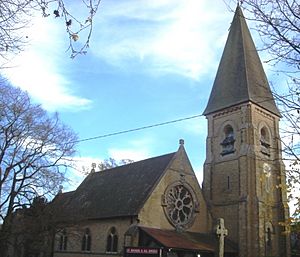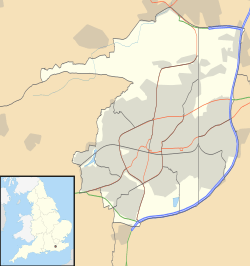St John the Baptist's Church, Crawley facts for kids
Quick facts for kids St John the Baptist, Crawley |
|
|---|---|

The church from the southeast
|
|
| 51°6′50″N 0°11′19″W / 51.11389°N 0.18861°W | |
| Denomination | Church of England |
| Churchmanship | Modern Catholic, Informal Charismatic |
| History | |
| Dedication | John the Baptist |
| Administration | |
| Parish | Crawley, St John the Baptist |
| Deanery | East Grinstead |
| Archdeaconry | Horsham |
| Diocese | Chichester |
| Province | Canterbury |
St John the Baptist's Church is an Anglican church located in Crawley, West Sussex, England. It serves as the main church for the Crawley area. This church is the oldest building in the town centre, first built around the 1250s. While it has been changed a lot over time, one original wall still stands. Since September 2017, a new team from St Peter's Brighton has helped St John's start a new chapter. The church offers different types of services, from traditional to more modern and relaxed ones. St John's is also part of the Holy Trinity Brompton (HTB) network of churches.
Contents
The History of St John's Church
How Crawley Got Its Own Church
Long ago, in the Norman times, places like Slaugham and Cuckfield were very important in Sussex. When Crawley started to grow as a village in the 1200s, it was part of Slaugham parish. A "parish" is an area served by a church. Crawley was far from Slaugham's main church, St Mary's. So, a stone church was built in Crawley. This new church was called a "chapel of ease." It made it easier for people in Crawley to go to church.
We know this church existed before 1267. By the early 1400s, it was seen as its own "free" church. This means Crawley became a separate parish from Slaugham. St John the Baptist's was the main church for Crawley by the 1540s. Crawley parish was quite small and narrow. The border between Crawley and Ifield parishes ran right through the middle of Crawley High Street.
Changes to the Church Building
The church building saw its first big changes in the 1400s. A tall tower was added at the west end. The windows in the main part of the church, called the nave, were made bigger. A special screen, called a rood screen, was put between the main seating area and the chancel (where the altar is). The roof of the nave was also rebuilt then. Some of the oldest carvings and memorials inside the church are from this time.
By the 1500s, Crawley was a busy market village. Its church became more important than Slaugham's. The legal link between the two churches was broken. Even though many people attended, the church didn't have much money. Priests often moved to richer parishes. The building started to fall apart in the 1600s and 1700s.
The Church Bells
In 1724, a survey found that the church had four bells, but only one worked. The other three were cracked. These old bells were melted down. In 1742, a bell maker named Thomas Lester made two new bells from the metal. These bells were inscribed with messages. Lester made many bells for churches in Sussex.
More big changes happened in the 1800s. The tower was partly rebuilt and made taller by 1814. Even more work was done in 1845. The biggest changes happened in 1879 and 1880. A new section, called a north aisle, was added. A porch was built on the north side. The chancel was completely rebuilt, and a room for the organ was added. Some people, like Nikolaus Pevsner, thought the church looked "dully Victorian" after these changes. However, the 15th-century nave roof, which was not changed, is still considered a beautiful part of the church.
During this time, the church also fixed its bells. The two bells made by Lester had cracked, and their wooden frame was rotten. The church decided to get a new set of eight bells. These were made by Gillett, Bland & Company in 1880. Each bell has a special inscription, like "GLORY" or "PRAYER." The bells hang in a strong oak frame. In 1931, one bell cracked and was remade. Over the years, other parts of the bell system were updated to keep them working well.
Famous Visitors and Local Legends
The church is very close to the old border of Ifield parish. People living on the west side of the High Street often came to St John the Baptist's. This was even if their official church was St Margaret's. One famous person who did this was Mark Lemon. He was the first editor of the funny magazine Punch. He lived in Crawley and regularly attended St John's. However, he was a large man. He had to sit in the gallery because the regular pews in the nave were not big enough for him!
People have reported seeing strange things around the church, graveyard, and church walk. The churchyard also holds the war graves of two soldiers from World War I and an airman from World War II.
Church Architecture
The church is built using a type of stone called Sussex limestone. The roof over the chancel is made of tiles. The rest of the church roof uses flat slabs of local stone. The south wall of the main church area is original, though it has some changes from the 1400s. The ceiling of the nave is also from the 1400s. It has special wooden supports called wind bracing and tie beams.
The tower was rebuilt in the 1800s. It has three levels and features old carvings from the Middle Ages. The pulpit, where the priest gives sermons, is from the 1600s. The altar rails are from the 1600s or early 1700s. There are some beautiful stained glass windows in the north aisle and at the east end of the chancel, added in the 1800s. The oldest item inside the church is the marble font, which is from the 1200s.
The Parish of St John the Baptist
Parish Boundaries
In October 2017, the size of the parish was made smaller. It now covers Crawley town centre. Its northernmost point is where Kilnmead road meets London road. Its southernmost point is where Goffs Park road meets Brighton Road.
Before this change, the parish was much larger. It covered most of the town west and north of the railway line. This included areas up to the edge of Gatwick Airport. The old boundary followed the A23 London Road and the southern road of Gatwick Airport. It also included land near Tinsley Green and part of the Southgate area.
Other Churches in the Parish

There are five churches still standing within the parish area.
- St Peter's in West Green was built between 1892 and 1893. It replaced an earlier chapel because West Green was far from its main parish church. St Peter's later became its own parish, but it is now part of St John the Baptist's parish.
- St Elizabeth's is in the centre of the Northgate area. It was built in 1965 and has a "Modern Catholic" style of worship, similar to St John the Baptist's.
- St Richard's is another modern church. It serves the Three Bridges area.
- A fifth church, St Michael and All Angels, is technically in the parish. However, it is no longer used for Anglican services. This church was designed by William Burges and built in 1867. It served the village of Lowfield Heath.
- The growth of Gatwick Airport nearby caused the small village of Lowfield Heath to disappear. All buildings except the church were taken down for airport expansion. The church is very close to the runway. The Diocese of Chichester stopped using the church for services in 2004. Since March 2008, a Seventh-day Adventist group has used the building for their worship.
St John's Church Today
Since September 2017, a team led by Steve and Liz Burston from St Peter's Brighton has helped St John's start a new chapter. They offer different types of services, both traditional and modern. The goal is to respect the past, manage the present, and build for the future.
St John's Crawley offers an Alpha course every school term. This course gives people a chance to talk freely about big questions about life, faith, and purpose from a Christian point of view. They also run programs to help the community, like The Bridge Café and Turning Point. Besides Sunday services, there are groups that meet during the week. These groups help people grow in their faith and connect with others. St John's believes that churches in Crawley should work together. They focus on helping the community and praying together.
See also
- List of places of worship in Crawley
- Listed buildings in Crawley


